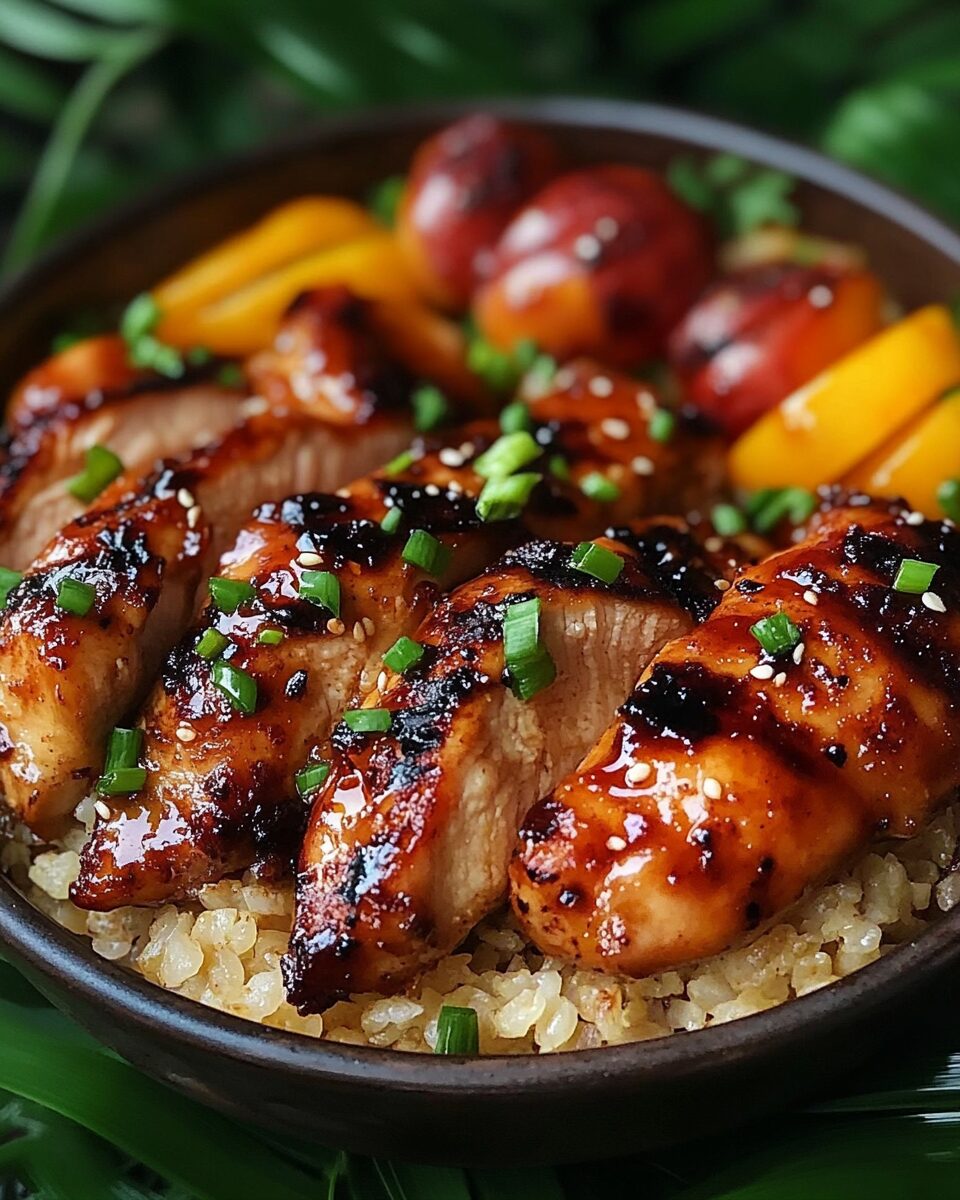Savor the taste of paradise with this Hawaiian-style Teriyaki Chicken! Juicy, tender chicken is marinated in a perfectly balanced sweet and savory teriyaki sauce, grilled or pan-cooked to caramelized perfection. It’s a tropical escape on a plate—simple to make and bursting with island flavor!
Full Recipe:
Ingredients
-
2 lbs boneless, skinless chicken thighs
-
1/2 cup soy sauce
-
1/2 cup brown sugar
-
1/4 cup pineapple juice (optional but adds tropical flavor)
-
1/4 cup mirin (or rice vinegar as a substitute)
-
2 tbsp fresh grated ginger
-
3 cloves garlic, minced
-
1 tbsp sesame oil
-
1 tbsp cornstarch + 2 tbsp water (optional, for thickening sauce)
-
Sesame seeds & chopped green onions (for garnish)
Directions
-
Prepare the Marinade:
In a bowl, whisk together soy sauce, brown sugar, pineapple juice, mirin, ginger, garlic, and sesame oil. -
Marinate the Chicken:
Place chicken thighs in a resealable bag or dish. Pour marinade over the chicken and refrigerate for at least 1 hour (preferably overnight for best flavor). -
Cook the Chicken:
-
Grill Method: Preheat grill to medium-high heat. Cook chicken 5–6 minutes per side or until fully cooked.
-
Stovetop Method: Heat a skillet or grill pan over medium-high heat. Sear chicken 5–6 minutes per side until caramelized and cooked through.
-
-
Optional Sauce Thickening:
Pour leftover marinade into a small saucepan. Bring to a boil, then reduce heat and simmer. Add cornstarch slurry to thicken if desired. -
Serve:
Slice chicken and serve over rice or with grilled pineapple. Drizzle with thickened sauce and garnish with sesame seeds and green onions.
Nutrients (estimated per serving, serves 4–6)
-
Calories: ~350 kcal
-
Protein: ~30g
-
Carbohydrates: ~18g
-
Fat: ~18g
-
Sugar: ~12g
-
Sodium: ~780mg
The Roots of Hawaiian Teriyaki Chicken
While teriyaki sauce is originally Japanese, the Hawaiian-style interpretation has its own unique flair. Brought to the islands by Japanese immigrants in the early 20th century, teriyaki evolved into something distinct thanks to Hawaii’s multicultural food scene and abundant access to tropical ingredients. In local plate lunches and family barbecues, Hawaiian teriyaki chicken stands as a symbol of this fusion—a blend of Japanese technique with Polynesian and American influences.
Pineapple juice, a hallmark of Hawaiian cooking, is one such adaptation. Its natural sweetness and acidity pair beautifully with the salty depth of soy sauce and the earthy warmth of ginger and garlic, creating a complex marinade that infuses every bite of chicken with island flavor.
Why Chicken Thighs Are the Ideal Choice
Boneless, skinless chicken thighs are the preferred cut for this dish for good reason. They’re juicier and more flavorful than chicken breasts, and they hold up better during grilling or pan-searing. Their higher fat content helps keep the meat tender and moist, even under high heat, while allowing the marinade to soak deep into the meat.
When cooked properly, chicken thighs develop a gorgeous caramelized crust that locks in flavor and creates that signature teriyaki glaze. This combination of texture and taste is what makes each bite of Hawaiian-style teriyaki chicken so memorable.
If you’re looking to customize the dish, boneless skin-on thighs add extra richness, while boneless breasts offer a leaner option. Just be mindful of cook time, as breast meat can dry out more easily without the same fat content.
The Magic of the Marinade
At the heart of this recipe is the marinade—a bold, balanced blend of soy sauce, brown sugar, pineapple juice, mirin, ginger, garlic, and sesame oil. Each component plays an important role in building flavor.
Soy sauce provides umami and saltiness, brown sugar gives a rich sweetness and encourages caramelization, and pineapple juice adds acidity and tropical flair. Mirin, a sweet Japanese rice wine, deepens the flavor and brings out the umami further. If mirin is unavailable, rice vinegar can be used as a tangy substitute, though it’s recommended to add a touch of extra sugar to keep the sweet-savory balance.
Fresh ginger and garlic add a spicy, aromatic punch that elevates the marinade beyond store-bought alternatives. Sesame oil brings in nutty, roasted notes that round out the profile and give the dish its signature warmth.
Marinating for at least an hour is essential, but overnight marination allows the flavors to fully penetrate the meat, resulting in deeper, more satisfying taste in every bite.
Grilling vs. Stovetop: Cooking Methods That Deliver
Hawaiian-style teriyaki chicken shines whether you grill it or cook it in a pan. Grilling imparts a smoky char that enhances the natural sweetness of the marinade and gives you that classic island barbecue taste. It’s perfect for summer cookouts or when you’re craving that flame-licked finish.
For those without a grill, a stovetop skillet or grill pan offers an excellent alternative. Cooking the chicken over medium-high heat allows the sugars in the marinade to caramelize into a beautiful glaze, while the pan helps retain the juiciness of the meat. Either way, the result is a golden-brown, flavorful chicken that’s versatile and easy to serve.
If you want an extra sticky sauce, the reserved marinade can be simmered and thickened with a cornstarch slurry to create a glossy drizzle. This extra step adds a finishing touch that makes the dish even more luxurious and restaurant-worthy.
The Power of Pairing: How to Serve Teriyaki Chicken
Hawaiian-style teriyaki chicken is endlessly versatile. Traditionally, it’s served over steamed white rice, allowing the grains to soak up the savory-sweet juices from the chicken. For a true Hawaiian plate lunch experience, serve it alongside creamy macaroni salad and a scoop of rice, or add grilled pineapple slices for a burst of sweetness.
It also works beautifully in rice bowls with sautéed vegetables, on top of salad greens for a lighter meal, or tucked into buns or wraps for teriyaki chicken sandwiches. You can even slice it and use it in sushi rolls or bento boxes.
For a healthy twist, pair it with brown rice, quinoa, or cauliflower rice, and add a medley of steamed broccoli, bok choy, or edamame. The balance of protein, fiber, and healthy carbs makes it both nutritious and satisfying.
A Nutrient-Rich Comfort Food
Despite its indulgent flavor, this dish is relatively balanced in terms of nutrition. With approximately 350 calories per serving, it offers about 30 grams of protein, making it an excellent source of energy and muscle-building fuel. The soy sauce and brown sugar contribute to its sodium and sugar content, but by using low-sodium soy sauce or adjusting sweeteners, it can easily be tailored to meet dietary goals.
Chicken thighs provide essential B vitamins, iron, and zinc, while the addition of garlic and ginger introduces natural anti-inflammatory and immune-boosting benefits. If you’re using pineapple juice, you’re also adding vitamin C and digestive enzymes like bromelain.
In short, this dish isn’t just tasty—it’s also packed with nutrients, offering a delicious way to nourish your body and enjoy every bite.
Tips for Success and Customization
For best results, be sure not to skip the marination step—it’s crucial to building flavor. If you’re short on time, even 30 minutes will impart some taste, but longer is always better.
Always preheat your grill or pan before adding the chicken to ensure good sear and caramelization. Avoid overcrowding the pan to allow each piece space to brown properly. Let the chicken rest a few minutes after cooking before slicing to keep it juicy.
To customize, you can add chili flakes or sriracha to the marinade for heat, swap out chicken for tofu or salmon for different proteins, or garnish with fresh cilantro or pickled red onions for added color and flavor.
Conclusion
Hawaiian-Style Teriyaki Chicken is more than just a meal—it’s a bite of the islands that brings warmth, comfort, and a burst of tropical flavor to your kitchen. With its tender, juicy chicken and rich, caramelized glaze, it captures the essence of Hawaiian cooking: simple, bold, and rooted in community and cultural fusion.






